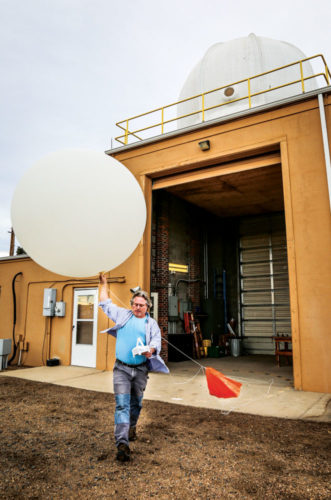

At The Urban Farm’s greenhouse, students participate in a program that teaches them about aquaponic gardening—raising fish and soiless growing of plants.
After a long wait for a written agreement, The Urban Farm is excited its official partnership with the City of Denver is about to begin. Signatures and City Council approval are expected soon. As property owner, the city will update the main building to bring it into compliance with the Americans With Disabilities Act (ADA), improve safety features, provide assistance with insurance and help create a long-term land management plan.

Mike Nicks, executive director of The Urban Farm, Kim Downing, Urban Farm board president, and two of The Urban Farm’s many goats are shown beside the new fencing that was built last year, following an attack by dogs that killed a dozen of their animals. The goats have gnawed on the sign that says, “Don’t let the goats out! (No matter what they say.)”
When The Urban Farm celebrates its annual FarmFest on October 14, visitors will find several new projects in the works.
Located on Smith Road just west of Havana, The Urban Farm has been introducing agriculture to the urban community since 1993. The educational campus includes community gardens, livestock, a horseback riding program, aquaponics and, soon, its very own weather station.
FarmFest

At FarmFest in 2017, families, along with a goat, gather to hear an animal story told by a Sam Gary librarian.
Every year, The Urban Farm opens its gates to the community for FarmFest. This year, October 14 will bring live music by Jesse Cornett, a country western singer renowned in the Greeley area. Kids will enjoy the large pumpkin patch and pumpkin-painting activities. And visitors will see the large flock of goats and sheep which now numbers 25, after recovering from a tragic dog attack early last year that killed a dozen animals at the farm, including its entire herd of goats.
The event will also include family-friendly activities and crafts and locally-sourced food and drink. For tickets and to learn more about The Urban Farm, go to theurbanfarm.org.
Community Garden
The Urban Farm houses a large community garden. According to Mike Nicks, executive director of The Urban Farm, about a third of the garden is rented to private gardeners, another third allotted to a cooperative program overseen by master gardeners, and the final third given over to educational purposes.

About a third of the garden is rented to private gardeners, another third allotted to a cooperative program overseen by master gardeners, and the final third is used for educational purposes.
New this year is a wire fence that protects the garden from the local prairie dogs. “There’s hardwire about a foot down and a foot out,” explains Nicks, and it runs around the entire perimeter of the garden. In several places, the wild rodents’ attempts to burrow under it were evident, but they have had little success in penetrating this cleverly designed barrier, much to the delight of the many Urban Farm gardeners who enjoy the space.Greenhouse
Construction on a new state-of-the-art greenhouse is almost complete. Boasting a fifteen-foot wet wall and a thermostat-controlled system of fans and ventilation, plus a propane heater for the winter, the greenhouse will be used year-round to grow crops. “I think basil will be one, since it seems to sell well,” says Nicks. “We’ll probably avoid tomatoes…and we’ll test stuff to see what works.”
The Farm mainly sells agricultural products to the public and takes any excess to nonprofit agencies that provide food to those in need. “The focus of this, like the rest of the farm, is we’re not necessarily a production facility, but we’re an educational facility,” says Urban Farm Board President, Kim Downing. They expect the greenhouse to be up and running to show the public by FarmFest in mid-October.

Even though the official weather station was removed from The Urban Farm, high altitude balloons to gather weather data continued to be launched there—and now the official weather station is being brought back to The Urban Farm.
Weather Station
The main building at The Urban Farm was once the site of a National Weather Service weather station. It served the old airport until the station was moved to City Park and then later decommissioned.
The Urban Farm has been working to bring the weather station back to its site, raising funds and dealing with bureaucratic red tape to get it back. “Weather obviously affects how the land is managed and everything about agriculture. The first thing that everyone does when they come out to the farm is check on the weather,” notes Downing.
Weather stations require unique siting—away from asphalt, large buildings and other factors that affect its measurement. It looks like efforts will finally pay off, probably later this year, when the weather station is returned to its original location.
“The exciting part for us is that there’s 70 years of data that [weathercaster] Mike Nelson has access to,” says Downing. “It will be really cool. During his newscasts, he’ll be able to say, ‘Out at The Urban Farm it’s 89 today and 60 years ago it was 79.’” The Urban Farm is also excited to start developing programming around the weather station.




0 Comments